Pathologists face immense pressure. They need to spot tiny details in tissue samples. A standard monitor might not show enough, leading to uncertainty.
A 4MP display offers significant clinical advantages in digital pathology by providing much higher pixel density. This enhanced resolution allows for clearer visualization of subtle cellular and nuclear features, crucial for accurate diagnosis and efficient workflow.
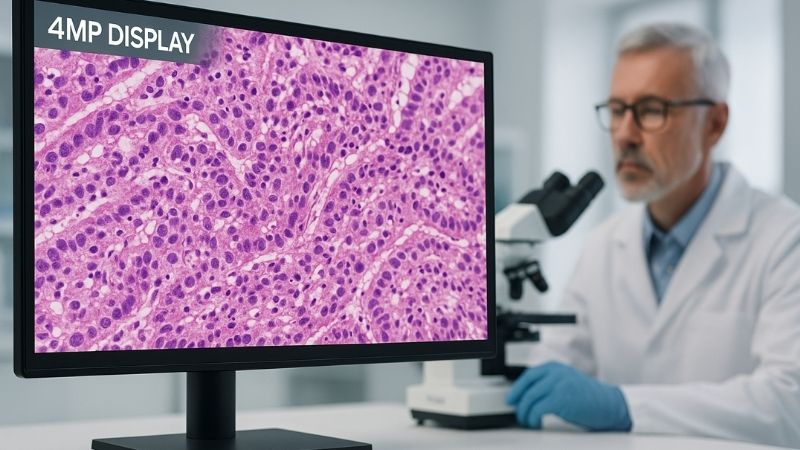
The shift to digital pathology1 is transforming how diagnoses are made. At Reshin, we understand the critical role of display technology in this field. Martin, our President, with his background in high-precision imaging systems, has always stressed the importance of seeing every detail. Pathologists, much like surgeons relying on clear views, need exceptional image quality2. A 4MP (approximately 4 million pixels) display is becoming a key tool. Let’s look into why this specific resolution offers real benefits for those reviewing digital slides day in and day out. The advantages are clear, and they directly impact patient care.
How does 4MP resolution enhance histological detail recognition?
Pathology relies on seeing tiny cell parts. Low resolution can hide these vital clues. Clearer images mean better, more confident findings.
4MP resolution enhances histological detail recognition by providing significantly more pixels per inch than lower-resolution displays. This allows for sharper, more distinct visualization of fine cellular structures, nuclear atypia, and subtle tissue patterns, reducing ambiguity.
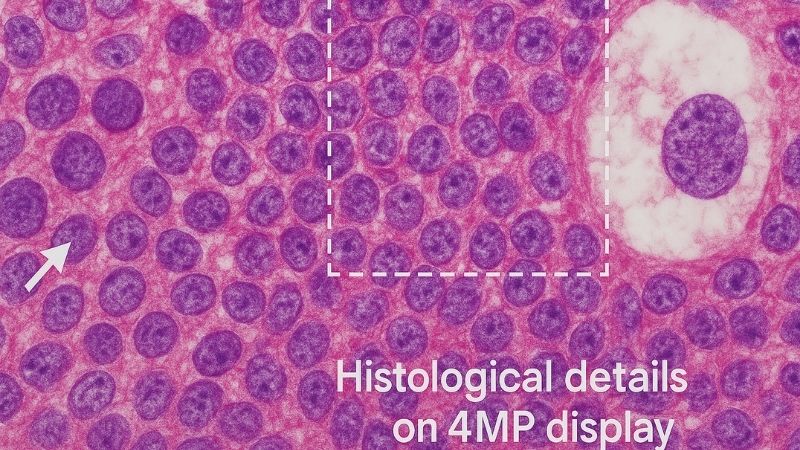
that the core of pathology is pattern recognition3 at a microscopic level. When a glass slide is digitized, the resulting image file is huge and full of information. A 4MP display4, with roughly twice the pixels of a standard 2MP (Full HD) monitor, makes a big difference in how this information is presented. My insight is that this higher pixel density is fundamental. It means pathologists can see more subtle cellular and nuclear details without needing to zoom in quite as aggressively. Think about looking for mitotic figures5, nuclear membrane irregularities, or chromatin patterns. These are often very small features. On a 4MP screen, these elements appear sharper and more defined. This clarity is closer to what one might expect from a traditional microscope but with the added benefits of digital tools. It’s not just about making the image look "better"; it’s about providing enough visual data for the pathologist to confidently identify and interpret these critical features. This can be especially important in complex cases or when subtle changes might indicate early stages of disease. We at Reshin believe that giving pathologists the best possible view directly supports more accurate and timely diagnoses.
Why is screen size and resolution balance critical in pathology review?
Looking at slides all day is demanding. The wrong screen can make it harder. Finding the right balance between size and detail is key.
The balance between screen size and 4MP resolution is critical because it ensures pathologists can view a sufficient area of a digital slide (field of view) at a diagnostically useful magnification without excessive pixelation or the need for constant, fatiguing zoom/pan actions.
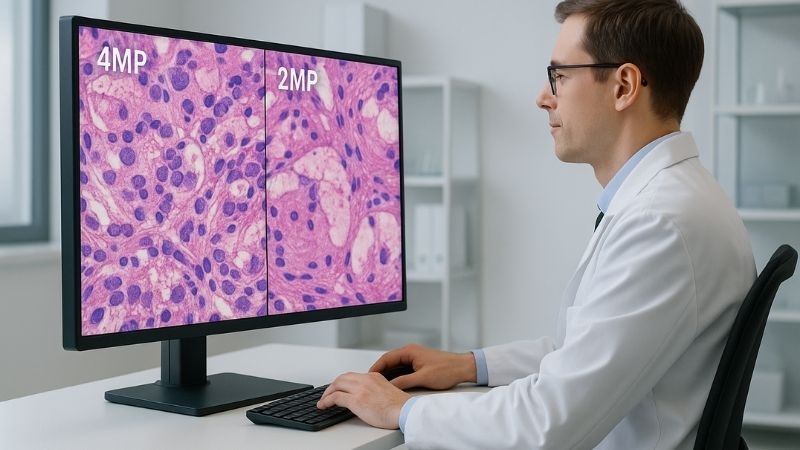
When discussing display needs with professionals , who focuses on precise equipment performance, the topic of balance always comes up. It’s not just about having the highest resolution; it’s about how that resolution is presented on a screen of a suitable size. For digital pathology, a 4MP display6, often on a 27-inch or 32-inch monitor, strikes an excellent balance. My insight here is that this combination reduces the need for excessive zooming and panning. Pathologists often need to see both the overall tissue architecture (low power view) and fine cellular details (high power view). A 4MP monitor allows them to see a good overview with enough detail to spot areas of interest. Then, when they do zoom in, the image remains sharp because of the high pixel density7. Compared to a 2MP display of the same size, a 4MP screen will show much finer detail at the same zoom level, or allow a wider field of view at a comparable level of detail. This efficiency is a big deal. Less zooming and panning means less time spent navigating the image and more time spent on actual diagnostic interpretation. This improves reading efficiency8 and also contributes to visual comfort over long review sessions. At Reshin, we aim for this optimal balance to support the demanding workflow of modern pathology.
Here’s a simple comparison:
| Feature | 2MP Display (e.g., Full HD) | 4MP Display (e.g., QHD/mini-4K) | Benefit of 4MP for Pathologists |
|---|---|---|---|
| Pixel Density | Lower | Higher | Sharper details, clearer cellular structures |
| Zoom/Pan Needs | More frequent | Less frequent | Faster review, reduced fatigue |
| Field of View | More restricted for detail | Wider at useful detail levels | Better context, easier to spot areas of interest |
| Overall Clarity | Good | Excellent | Increased diagnostic confidence |
How does a 4MP display impact diagnostic accuracy and consistency?
Accurate diagnosis is paramount. Every tool should support this. A high-quality display can help ensure consistent and reliable results.
A 4MP display impacts diagnostic accuracy by providing a clearer, more detailed view of histological features, reducing the chance of misinterpretation. It supports consistency by enabling standardized, high-fidelity image presentation across different review stations, especially when calibrated.
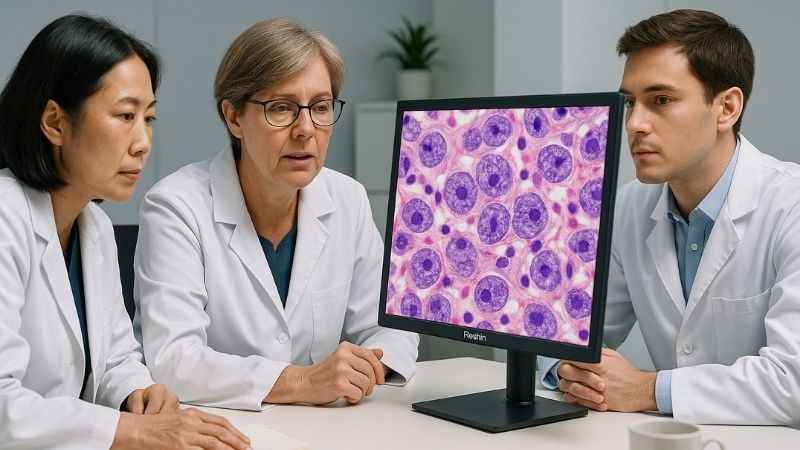
The ultimate goal in pathology is an accurate and consistent diagnosis. I believe that the quality of the display plays a direct role in achieving this. A 4MP monitor9 contributes in several ways. Firstly, the enhanced detail, as we’ve discussed, allows pathologists to see subtle cues that might be missed or misinterpreted on a lower-resolution screen. This can be crucial for grading tumors, identifying infectious agents, or recognizing rare cell types. My insight here is that consistency across review stations is also vital, particularly in large-scale digital pathology workflows where multiple pathologists might review images. If different monitors show the same slide with varying levels of detail or color fidelity, it can lead to inter-observer variability10. Using calibrated 4MP monitors11 across a department helps to establish a standardized viewing environment. This means that all pathologists are essentially seeing the same high-quality image, which promotes more consistent interpretations. Martin has always emphasized that in any medical imaging, from surgery to pathology, consistent image presentation is key for reliable decision-making. At Reshin, we focus on providing displays that not only offer high resolution but also maintain image quality and can be calibrated to meet stringent medical standards, supporting both individual accuracy and team consistency.
Can a 4MP monitor support multi-slide or comparison viewing effectively?
Pathologists often compare slides. They look at current and past samples. A good monitor needs to show these side-by-side clearly.
Yes, a 4MP monitor can effectively support multi-slide or comparison viewing. Its higher resolution and pixel density allow for two or more digital slides or regions of interest to be displayed side-by-side with sufficient detail for meaningful comparison, aiding consultative and teaching activities.
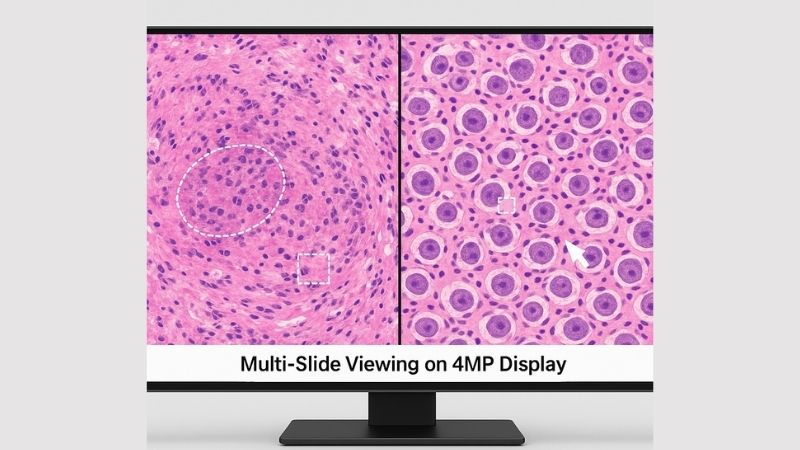
In my experience, pathologists don’t just look at one image in isolation. They often need to compare different stains of the same tissue, review previous biopsies, or consult with colleagues by looking at images together. This is where a 4MP monitor’s ability to handle multi-slide or comparison viewing12 becomes very valuable. My insight is that the increased screen real estate, combined with the high pixel density, allows for clear side-by-side display. Imagine comparing an H&E stain with an IHC stain for the same tissue sample. On a 4MP display, both images can be shown with enough clarity that the pathologist can effectively correlate findings between them without constantly switching views or losing detail. This is also crucial for teaching scenarios. A mentor can show a trainee different examples or highlight subtle differences between cases simultaneously. In consultative pathology, where a second opinion is sought, being able to view the primary slide and any comparative images clearly on one screen facilitates better discussion and decision-making. The 4MP resolution ensures that even when the screen is split, each portion still retains enough detail for diagnostic purposes. This capability makes the workflow more efficient and collaborative, which are key benefits of digital pathology13.
What ergonomic benefits does a 4MP display offer for long pathology sessions?
Pathologists spend hours at screens. This can cause strain and fatigue. Better ergonomics can make a big difference in their workday.
A 4MP display offers ergonomic benefits by allowing pathologists to see a larger, more detailed overview of a digital slide. This reduces the need for constant, fine-motor adjustments with zoom/pan controls and lessens eye strain associated with discerning details on lower-resolution screens, especially during long sessions.
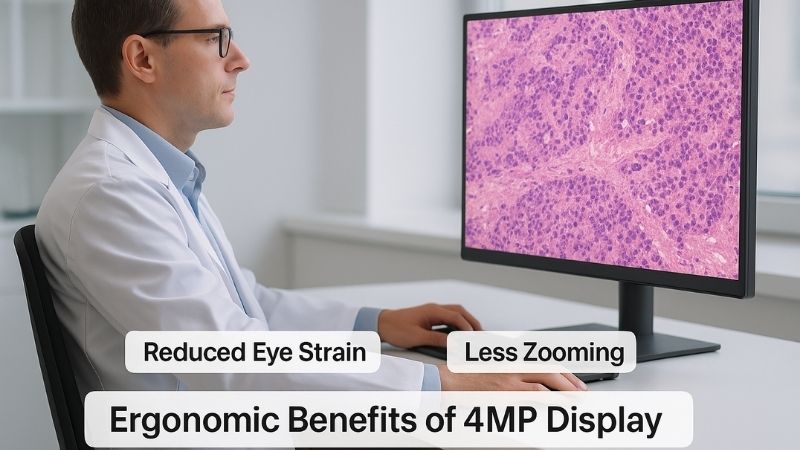
We at Reshin always consider the user experience, especially for professionals who spend many hours a day looking at screens. Pathologists are definitely in this group. The ergonomic benefits[^14] of a 4MP display are significant. My primary insight here is that a 4MP monitor can allow for a comfortable viewing experience because it provides a full-slide overview with good detail, and zoomed-in inspection without significant image degradation or pixelation. This means less physical strain. Think about it: if you can see more of the slide clearly at one time, or get the detail you need with less zooming, you’re making fewer mouse movements and less frequent adjustments to your focus. This reduces the repetitive strain on the hand and wrist. Also, the clearer, sharper image quality14 provided by 4MP resolution can reduce eye strain. Trying to discern very fine details on a blurry or pixelated image for hours is incredibly fatiguing for the visual system. A crisp image is simply easier and more comfortable to look at. When pathologists are more comfortable, they can maintain concentration for longer periods, which is essential for the demanding work they do. This focus on ergonomics is about supporting the well-being and sustained performance of these critical medical professionals.
Key ergonomic advantages:
| Ergonomic Factor | Impact of 4MP Display | Benefit for Pathologist |
|---|---|---|
| Reduced Zoom/Pan | Clearer view at lower magnifications, less need for deep zooms. | Less repetitive hand/wrist motion, reduced RSI risk. |
| Eye Strain | Sharper, crisper images are easier for eyes to process. | Decreased visual fatigue over long sessions. |
| Head/Neck Posture | Optimal viewing distance with clear detail. | More comfortable posture, less neck/shoulder pain. |
| Workflow Efficiency | Faster navigation and interpretation of slide data. | Less time spent on image manipulation, more on diagnosis. |
Conclusion
In essence, a 4MP display significantly enhances digital pathology by improving detail recognition, diagnostic accuracy, and workflow efficiency, while also offering better ergonomics for pathologists.
Learn how Reshin’s 4MP diagnostic monitors can advance your digital pathology workflow—contact us at martin@reshinmonitors.com.
- Exploring this resource will provide insights into how digital pathology enhances diagnostic accuracy and patient care. ↩
- Understanding the impact of image quality on diagnostics can help appreciate the advancements in pathology technology. ↩
- Learn about the importance of pattern recognition in pathology and how it aids in identifying diseases effectively. ↩
- Explore how a 4MP display enhances image clarity and detail for pathologists, improving diagnostic accuracy. ↩
- Discover the significance of mitotic figures in diagnosing diseases and how they are identified under a microscope. ↩
- Explore the advantages of 4MP displays in digital pathology for improved detail and efficiency in diagnostics. ↩
- Learn how high pixel density enhances image quality, crucial for accurate diagnostics in pathology. ↩
- Discover effective strategies to enhance reading efficiency, vital for pathologists in their workflow. ↩
- Explore how a 4MP monitor enhances diagnostic accuracy and consistency in pathology, crucial for effective medical decision-making. ↩
- Learn strategies to reduce inter-observer variability, ensuring more reliable and consistent diagnoses among pathologists. ↩
- Discover the significance of calibrated monitors in maintaining image quality and consistency in medical imaging environments. ↩
- Learn about the advantages of multi-slide viewing in pathology and how it aids in accurate diagnosis and teaching. ↩
- Discover the transformative impact of digital pathology on efficiency, collaboration, and diagnostic accuracy in healthcare.[^14]: Learn about the ergonomic advantages of 4MP monitors and how they can improve comfort and productivity for professionals. ↩
- Discover the impact of image quality on pathologists’ work efficiency and eye strain reduction. ↩

